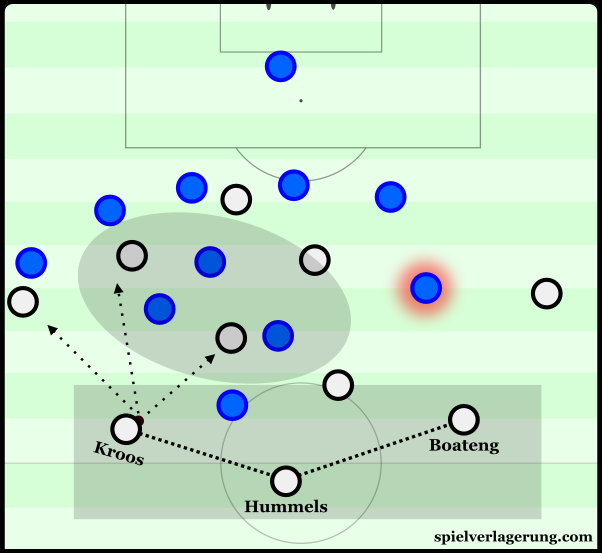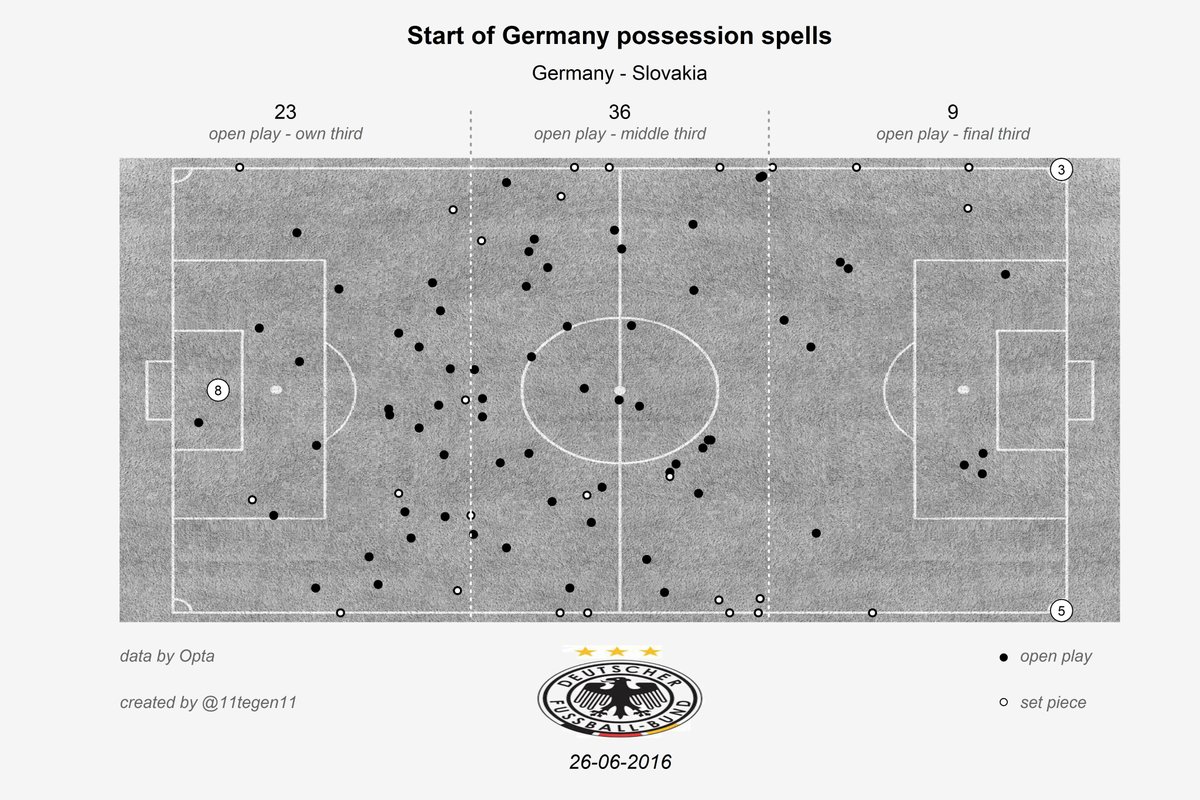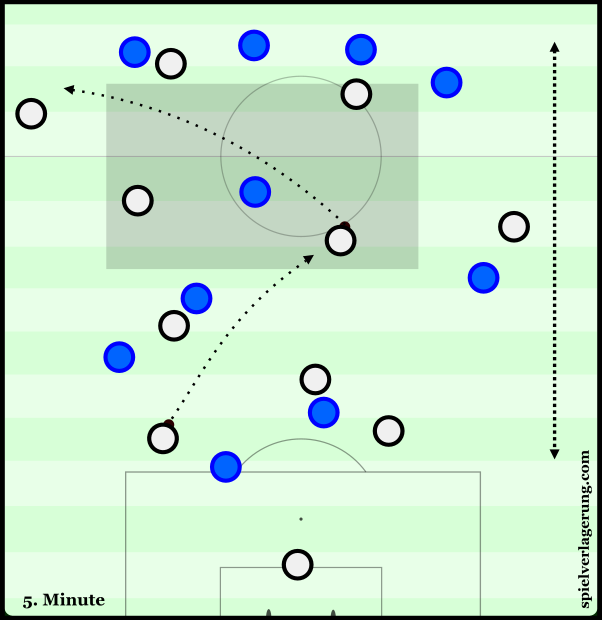Dynamic Germany ease past open Slovakian defence
After failing to convert their chances against Northern Ireland, we saw a much more clinical performance from Germany as they eased passed Slovakia in the first knockout game with a dominant performance.
Coming off of a shaky yet important draw against England, Slovakia opted for a 4-1-4-1 shape once again despite personnel changes across the team. In the defensive line, Gyomber made an appearance at right-back in place of Hubocan whilst the midfield also saw a reshuffle. Skriniar took on the 6 position ahead of Pecovksy and Kucka moved out to the right whilst Hrosovsky took on his right-8 position. In the lone strikers’ position, Duric replaced Duda in leading the counter-attack.
In the German dugout, Löw made just one change to the starting eleven as Mario Götze was replaced by Julian Draxler who went on to make a strong performance in the attacking midfield.
Half-Space Liberi
Germany enforced their dominance early in the game and looked particularly impressive in the construction phase of their possession. With a base of Hummels, Boateng, Kroos and Khedira they had great playmakers in the first and second lines of players who circulated the ball well against an open Slovakian press. Boateng and Kroos were particularly expansive in their orientation and operated in the right and left half-spaces respectively from which they could move upwards and join the midfield situationally. The Kroos – Hummels – Boateng three-chain covered the width of the pitch effectively whilst the full-backs had the freedom to occupy advanced positions in order to stretch the opposition higher. The structure gave them strong control over the deeper spaces of the pitch and the efficient distances between players made horizontal ball circulation sharp and effective.
Against Slovakia’s 4-1-4-1, the pairing found space quite frequently within their half-spaces as Kroos in particular created room for himself with intelligent movements into such deeper positions. The half-space provided a suitable position which was just out of the reach of Duris whilst the ball-near central midfielder and winger struggled to establish access. Although Hamsik would sometimes step up to create a 4-4-1-1 shape, the pressure was generally non-existent against some of the best passers in the world. From these areas they could both dictate the start of Germany’s possessions well against Slovakia’s press and form an important foundation for the attacks in the final third. The deep positions within the half-spaces provided strong angles to break the midfield line with options vertically as well as in both directions diagonally.
In alternative moments, the playmaking responsibility fell upon the adept shoulders of Mats Hummels as Kroos took a more orthodox position on the inside. With all Slovakian players behind the ball, the newly-signed Bayern centre-back had more freedom to push outwards even without a teammate covering. Similarly to Kroos, Hummels had ample space and time with which he could find openings in order to use his excellent capacity to distribute the ball.
They were able to play a number of direct passes straight into the open gaps in midfield as Slovakia’s failed press was unable to enforce any true pressure. Draxler and Özil were able to occupy the vacant holes within the opposition’s defence and the passing ability of Germany’s deeper players made access relatively simple.
Typically-Dominant First Half
Germany’s excellence in the early stages of possession translated smoothly into an all-round strong showing against the team who were the last to beat them 4 weeks prior. The attacking midfield three were typically flexible with Draxler and Müller having particularly dynamic roles within the attack. Both Kimmich and Hector were stretching the Slovakian defence from extremely high positions which at times lead to a rough 2-2-5-1 formation.
Once again Löw’s team dominated possession of the ball yet unlike other top teams in this tournament, they were able to use the ball to good effect in creating chances within the final third. The circulation was dynamic and they were able to penetrate variable zones on the pitch whilst maintaining security in deeper positions against a Slovakian counter which had tested other teams. Their use of the ball as a tool sets them aside from other teams who have been unable to properly penetrate deep defences with the offensive movement of Müller and Gomez an influential factor.
As shown by the graphic to the left, German occupied a position very high up the pitch and were able to gain a territorial advantage over their opponents. Through an intelligent positional game and fluid ball movement, they not only had the ball for long periods but controlled the game with the use of it. Slovakia were pinned back for considerable spells as they hoped to hit them on the break.
Another important factor in Germany’s match-control was their ability to regain the ball quickly upon losing it. Although their pressing had some flaws (as I will come to explain later), they were able to quickly put the Slovakians under pressure upon a turnover and their counterpressing allowed them to regain the ball on a number of occasions. With a strong shape initially, they were often in a good position to began an immediate counterpress and they forced a number of clearances from the opposition which landed at the feet of the centre-backs, who anticipated well.
Weak Slovakian Defence
Whilst they only just hung on at times against England, Slovakia were opened up on an even more frequent basis when faced with the World Champions’ attack. It was interesting to see the Eastern European side attempt to enforce a high press similar to their performance against the Brits, yet this strategy gave little profit due to its uncoordinated nature. Whilst it generally struggled against the likes of Cahill and Smalling, it was unsurprisingly carved open by Hummels and Boateng. They were frequently uncompact when trying to take up such advanced positions and their inability to maintain defensive access made them susceptible to Germany’s excellent build-up.
Upon dropping back into a deeper position, Slovakia held a 4-1-4-1 shape which could often become a 5-1-3-1 or even a 6-1-2-1 due to the orientation of the two wide men. Both Weiss and Kucka would commonly drop to the side of their full-back as they tracked the movements of Kimmich and Hector respectively. This only served to weaken Slovakia’s coverage of the midfield spaces and it allowed the opposition to further enforce their control over the ball in such high positions.
From this 4-1-4-1, Hamsik took on slightly higher positions at times and occupied a line slightly higher than the rest of his midfielders. Against England, the star midfielder moved all the way to the striker’s line in order to support the press in a 4-4-2 and although he didn’t reach these heights against Germany, he was more active in his attempts to press from midfield. He not only could theoretically support Duris in the pressure but it would also allow for better coverage of the spaces in front of the midfield.
As for their play in possession, they once again looked to focus on creating chances in transitions. Weiss drove the ball forward in a few left-sided counter-attacks but for the most part they were ineffective. Germany’s superior structure and counterpressing abilities allowed them to better quash out many Slovakian attempts at breaking forward at pace. They had some isolated moments of success in sustained position by using fast combinations to beat the man-oriented pressing of Germany through way of dynamic superiority. By quickly combining between players, the German defenders couldn’t anticipate and cover the actions fast enough which lead to Slovakia breaking through the midfield on a couple of scenes.
The idea of defending with the man as the primary (and often, only) reference point is a flawed one. This is not least because the defender has to anticipate the attacker’s movements and this reaction time can be key for the attacker to get a head start (because obviously, he knows what he will do next – unless he happens to be Nani). The speed of Slovakia’s combination helped to undo German’s man-oriented press because they were able to pass the ball between themselves before the opposition could properly react and defend the action accordingly.
Yet despite these small moments of success, Slovakia were for the most part restricted by an impressive German defence. Slovakia’s technical inferiority was on show when closed down by Germany’s front line and Löw’s team were able to regain the ball in dangerous positions.
Slovakia Restart on Top
With Germany 2-0 up at the break, Slovakia had to re-think their plan in order to try and have some hope at miraculously turning the game around. A substitution was made as the teams reappeared with Vladimir Weiss making way for Jan Gresus. The introduced player fitted into the defensive midfield position whilst Hamsik now occupied a more advanced position on the left of the attack. With this change, the team appeared to play in a different shape and looked to be mainly a 4-3-2-1 whilst in some situations a 4-4-2 with Hamsik’s role higher up.
The change seemed to have worked as the underdogs improved considerably at the start of the second 45. Their attack carried more threat as they occupied a position higher up the pitch with Duris receiving better support from his fellow attackers. Their more offensive approach to the game gave them a threat which was completely missing in the first half and although their attacks weren’t always clean, they moved the ball more vertically and with better momentum and synergy. Combinations were more composed and used to greater effect as a means of avoiding German pressure whilst players higher up the pitch were able to find gaps more against Germany’s uncoordinated man-oriented defence.
On the other hand, Germany looked less of the team which had played so well in the first half. They struggled to keep control over ball possession for as long spells whilst Slovakia’s fast start took them somewhat by surprise. Their counterpressing was much less influential and they instead allowed Slovakia to establish better developed attacks. Although counter-attacking showed some promise, their opponents had a much better share of the attacks in comparison to the first half, whilst at times individual players showed slight panic with poor decision making.
It took until the 61st minute for Germany to settle down with a sustained and more calmed period of ball possession and from the resulting corner of that play, Draxler killed off Slovakia’s hopes by adding a third. Despite another setback, Slovakia still showed signs of superiority and it took until around the 70th minute for Germany to reinstate their dominance on the pitch. With the game settled, Jogi Löw decided to have his own personal fun and gave yet another cap to both Podolski and Schweinsteiger. Julian Weigl watched on from the bench.
Conclusion
Germany put in another strong performance in the first knockout round but combined it with a clinical nature which has been lacking previously. They undoubtedly deserved to progress at Slovakia’s cost as the Eastern European team failed to impress past a 20 minute period at the start of the 2nd half.









Keine Kommentare vorhanden Alle anzeigen